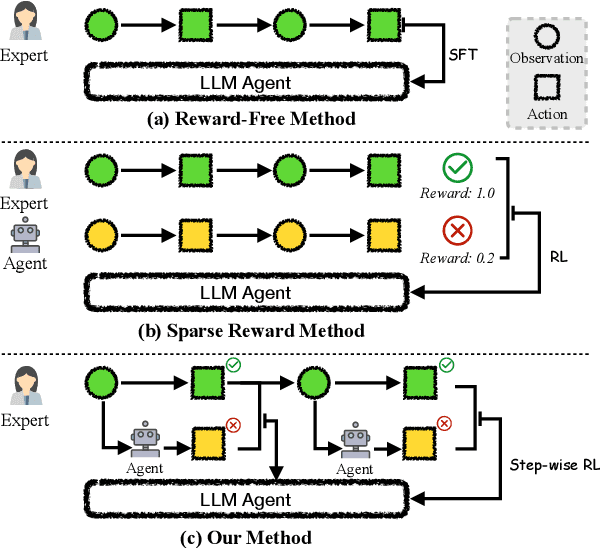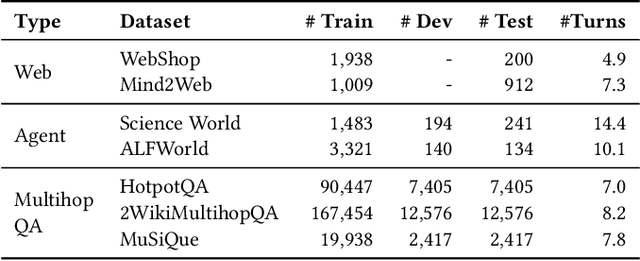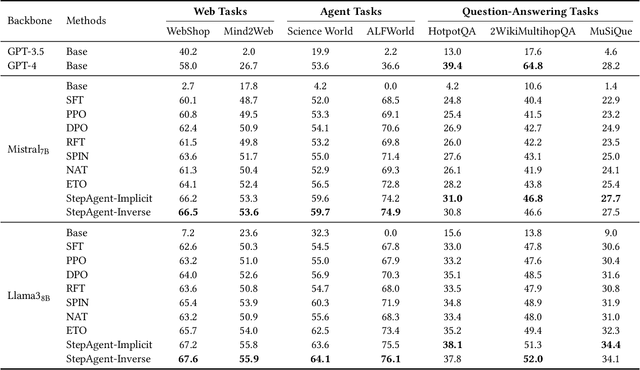Yutao Zhu
CoRanking: Collaborative Ranking with Small and Large Ranking Agents
Apr 01, 2025Abstract:Large Language Models (LLMs) have demonstrated superior listwise ranking performance. However, their superior performance often relies on large-scale parameters (\eg, GPT-4) and a repetitive sliding window process, which introduces significant efficiency challenges. In this paper, we propose \textbf{CoRanking}, a novel collaborative ranking framework that combines small and large ranking models for efficient and effective ranking. CoRanking first employs a small-size reranker to pre-rank all the candidate passages, bringing relevant ones to the top part of the list (\eg, top-20). Then, the LLM listwise reranker is applied to only rerank these top-ranked passages instead of the whole list, substantially enhancing overall ranking efficiency. Although more efficient, previous studies have revealed that the LLM listwise reranker have significant positional biases on the order of input passages. Directly feed the top-ranked passages from small reranker may result in the sub-optimal performance of LLM listwise reranker. To alleviate this problem, we introduce a passage order adjuster trained via reinforcement learning, which reorders the top passages from the small reranker to align with the LLM's preferences of passage order. Extensive experiments on three IR benchmarks demonstrate that CoRanking significantly improves efficiency (reducing ranking latency by about 70\%) while achieving even better effectiveness compared to using only the LLM listwise reranker.
MCLRL: A Multi-Domain Contrastive Learning with Reinforcement Learning Framework for Few-Shot Modulation Recognition
Feb 26, 2025Abstract:With the rapid advancements in wireless communication technology, automatic modulation recognition (AMR) plays a critical role in ensuring communication security and reliability. However, numerous challenges, including higher performance demands, difficulty in data acquisition under specific scenarios, limited sample size, and low-quality labeled data, hinder its development. Few-shot learning (FSL) offers an effective solution by enabling models to achieve satisfactory performance with only a limited number of labeled samples. While most FSL techniques are applied in the field of computer vision, they are not directly applicable to wireless signal processing. This study does not propose a new FSL-specific signal model but introduces a framework called MCLRL. This framework combines multi-domain contrastive learning with reinforcement learning. Multi-domain representations of signals enhance feature richness, while integrating contrastive learning and reinforcement learning architectures enables the extraction of deep features for classification. In downstream tasks, the model achieves excellent performance using only a few samples and minimal training cycles. Experimental results show that the MCLRL framework effectively extracts key features from signals, performs well in FSL tasks, and maintains flexibility in signal model selection.
mmE5: Improving Multimodal Multilingual Embeddings via High-quality Synthetic Data
Feb 12, 2025Abstract:Multimodal embedding models have gained significant attention for their ability to map data from different modalities, such as text and images, into a unified representation space. However, the limited labeled multimodal data often hinders embedding performance. Recent approaches have leveraged data synthesis to address this problem, yet the quality of synthetic data remains a critical bottleneck. In this work, we identify three criteria for high-quality synthetic multimodal data. First, broad scope ensures that the generated data covers diverse tasks and modalities, making it applicable to various downstream scenarios. Second, robust cross-modal alignment makes different modalities semantically consistent. Third, high fidelity ensures that the synthetic data maintains realistic details to enhance its reliability. Guided by these principles, we synthesize datasets that: (1) cover a wide range of tasks, modality combinations, and languages, (2) are generated via a deep thinking process within a single pass of a multimodal large language model, and (3) incorporate real-world images with accurate and relevant texts, ensuring fidelity through self-evaluation and refinement. Leveraging these high-quality synthetic and labeled datasets, we train a multimodal multilingual E5 model mmE5. Extensive experiments demonstrate that mmE5 achieves state-of-the-art performance on the MMEB Benchmark and superior multilingual performance on the XTD benchmark. Our codes, datasets and models are released in https://github.com/haon-chen/mmE5.
Search-o1: Agentic Search-Enhanced Large Reasoning Models
Jan 09, 2025



Abstract:Large reasoning models (LRMs) like OpenAI-o1 have demonstrated impressive long stepwise reasoning capabilities through large-scale reinforcement learning. However, their extended reasoning processes often suffer from knowledge insufficiency, leading to frequent uncertainties and potential errors. To address this limitation, we introduce \textbf{Search-o1}, a framework that enhances LRMs with an agentic retrieval-augmented generation (RAG) mechanism and a Reason-in-Documents module for refining retrieved documents. Search-o1 integrates an agentic search workflow into the reasoning process, enabling dynamic retrieval of external knowledge when LRMs encounter uncertain knowledge points. Additionally, due to the verbose nature of retrieved documents, we design a separate Reason-in-Documents module to deeply analyze the retrieved information before injecting it into the reasoning chain, minimizing noise and preserving coherent reasoning flow. Extensive experiments on complex reasoning tasks in science, mathematics, and coding, as well as six open-domain QA benchmarks, demonstrate the strong performance of Search-o1. This approach enhances the trustworthiness and applicability of LRMs in complex reasoning tasks, paving the way for more reliable and versatile intelligent systems. The code is available at \url{https://github.com/sunnynexus/Search-o1}.
YuLan-Mini: An Open Data-efficient Language Model
Dec 24, 2024



Abstract:Effective pre-training of large language models (LLMs) has been challenging due to the immense resource demands and the complexity of the technical processes involved. This paper presents a detailed technical report on YuLan-Mini, a highly capable base model with 2.42B parameters that achieves top-tier performance among models of similar parameter scale. Our pre-training approach focuses on enhancing training efficacy through three key technical contributions: an elaborate data pipeline combines data cleaning with data schedule strategies, a robust optimization method to mitigate training instability, and an effective annealing approach that incorporates targeted data selection and long context training. Remarkably, YuLan-Mini, trained on 1.08T tokens, achieves performance comparable to industry-leading models that require significantly more data. To facilitate reproduction, we release the full details of the data composition for each training phase. Project details can be accessed at the following link: https://github.com/RUC-GSAI/YuLan-Mini.
Sliding Windows Are Not the End: Exploring Full Ranking with Long-Context Large Language Models
Dec 19, 2024Abstract:Large Language Models (LLMs) have shown exciting performance in listwise passage ranking. Due to the limited input length, existing methods often adopt the sliding window strategy. Such a strategy, though effective, is inefficient as it involves repetitive and serialized processing, which usually re-evaluates relevant passages multiple times. As a result, it incurs redundant API costs, which are proportional to the number of inference tokens. The development of long-context LLMs enables the full ranking of all passages within a single inference, avoiding redundant API costs. In this paper, we conduct a comprehensive study of long-context LLMs for ranking tasks in terms of efficiency and effectiveness. Surprisingly, our experiments reveal that full ranking with long-context LLMs can deliver superior performance in the supervised fine-tuning setting with a huge efficiency improvement. Furthermore, we identify two limitations of fine-tuning the full ranking model based on existing methods: (1) sliding window strategy fails to produce a full ranking list as a training label, and (2) the language modeling loss cannot emphasize top-ranked passage IDs in the label. To alleviate these issues, we propose a new complete listwise label construction approach and a novel importance-aware learning objective for full ranking. Experiments show the superior performance of our method over baselines. Our codes are available at \url{https://github.com/8421BCD/fullrank}.
Progressive Multimodal Reasoning via Active Retrieval
Dec 19, 2024



Abstract:Multi-step multimodal reasoning tasks pose significant challenges for multimodal large language models (MLLMs), and finding effective ways to enhance their performance in such scenarios remains an unresolved issue. In this paper, we propose AR-MCTS, a universal framework designed to progressively improve the reasoning capabilities of MLLMs through Active Retrieval (AR) and Monte Carlo Tree Search (MCTS). Our approach begins with the development of a unified retrieval module that retrieves key supporting insights for solving complex reasoning problems from a hybrid-modal retrieval corpus. To bridge the gap in automated multimodal reasoning verification, we employ the MCTS algorithm combined with an active retrieval mechanism, which enables the automatic generation of step-wise annotations. This strategy dynamically retrieves key insights for each reasoning step, moving beyond traditional beam search sampling to improve the diversity and reliability of the reasoning space. Additionally, we introduce a process reward model that aligns progressively to support the automatic verification of multimodal reasoning tasks. Experimental results across three complex multimodal reasoning benchmarks confirm the effectiveness of the AR-MCTS framework in enhancing the performance of various multimodal models. Further analysis demonstrates that AR-MCTS can optimize sampling diversity and accuracy, yielding reliable multimodal reasoning.
Bench2Drive-R: Turning Real World Data into Reactive Closed-Loop Autonomous Driving Benchmark by Generative Model
Dec 11, 2024Abstract:For end-to-end autonomous driving (E2E-AD), the evaluation system remains an open problem. Existing closed-loop evaluation protocols usually rely on simulators like CARLA being less realistic; while NAVSIM using real-world vision data, yet is limited to fixed planning trajectories in short horizon and assumes other agents are not reactive. We introduce Bench2Drive-R, a generative framework that enables reactive closed-loop evaluation. Unlike existing video generative models for AD, the proposed designs are tailored for interactive simulation, where sensor rendering and behavior rollout are decoupled by applying a separate behavioral controller to simulate the reactions of surrounding agents. As a result, the renderer could focus on image fidelity, control adherence, and spatial-temporal coherence. For temporal consistency, due to the step-wise interaction nature of simulation, we design a noise modulating temporal encoder with Gaussian blurring to encourage long-horizon autoregressive rollout of image sequences without deteriorating distribution shifts. For spatial consistency, a retrieval mechanism, which takes the spatially nearest images as references, is introduced to to ensure scene-level rendering fidelity during the generation process. The spatial relations between target and reference are explicitly modeled with 3D relative position encodings and the potential over-reliance of reference images is mitigated with hierarchical sampling and classifier-free guidance. We compare the generation quality of Bench2Drive-R with existing generative models and achieve state-of-the-art performance. We further integrate Bench2Drive-R into nuPlan and evaluate the generative qualities with closed-loop simulation results. We will open source our code.
From Novice to Expert: LLM Agent Policy Optimization via Step-wise Reinforcement Learning
Nov 06, 2024



Abstract:The outstanding capabilities of large language models (LLMs) render them a crucial component in various autonomous agent systems. While traditional methods depend on the inherent knowledge of LLMs without fine-tuning, more recent approaches have shifted toward the reinforcement learning strategy to further enhance agents' ability to solve complex interactive tasks with environments and tools. However, previous approaches are constrained by the sparse reward issue, where existing datasets solely provide a final scalar reward for each multi-step reasoning chain, potentially leading to ineffectiveness and inefficiency in policy learning. In this paper, we introduce StepAgent, which utilizes step-wise reward to optimize the agent's reinforcement learning process. Inheriting the spirit of novice-to-expert theory, we first compare the actions of the expert and the agent to automatically generate intermediate rewards for fine-grained optimization. Additionally, we propose implicit-reward and inverse reinforcement learning techniques to facilitate agent reflection and policy adjustment. Further theoretical analysis demonstrates that the action distribution of the agent can converge toward the expert action distribution over multiple training cycles. Experimental results across various datasets indicate that StepAgent outperforms existing baseline methods.
Little Giants: Synthesizing High-Quality Embedding Data at Scale
Oct 24, 2024Abstract:Synthetic data generation has become an increasingly popular way of training models without the need for large, manually labeled datasets. For tasks like text embedding, synthetic data offers diverse and scalable training examples, significantly reducing the cost of human annotation. However, most current approaches rely heavily on proprietary models like GPT-4, which are expensive and inefficient for generating large-scale embedding data. In this paper, we introduce SPEED, a framework that aligns open-source small models (8B) to efficiently generate large-scale synthetic embedding data. Through supervised fine-tuning, preference optimization, and self-improvement, SPEED enables small open-source models to produce high-quality data. Remarkably, SPEED uses only less than 1/10 of the GPT API calls, outperforming the state-of-the-art embedding model E5_mistral when both are trained solely on their synthetic data. Using this efficient generator, we conduct a comprehensive study on how various factors within the alignment pipeline impact data quality and reveal the scaling law for synthetic embedding data.
 Add to Chrome
Add to Chrome Add to Firefox
Add to Firefox Add to Edge
Add to Edge